The Acer Nitro 5 Review: Renoir And Turing On A Budget
by Brett Howse on October 9, 2020 8:00 AM ESTSystem Performance: AMD Renoir H
AMD’s Renoir platform has been a game-changer in the laptop space for the Santa Clara company. With the previous laptop platform, Picasso, AMD offered competitive,, but not class-leading performance, especially on their integrated GPU, but were let down by high platform power draw, which was a major hurdle to overcome in a battery-powered device. Also, Picasso featured the AMD Zen CPU cores, whereas AMD’s desktop platform had moved to Zen 2. With the introduction of the AMD 4000 series laptop platform known as Renoir, AMD really delivered a triple-punch, moving to their newest 7 nm Zen 2 cores, as well as addressing their high idle power draw, and offering up to eight cores and sixteen threads in both their U-Series 15-Watt designs, and H / HS series 45-Watt / 35-Watt laptop processors. AMD went from “competitive, but” to class-leading overnight.
For a full deep-dive into the AMD 4000 platform, please check out Ian’s launch-day review featuring the AMD Ryzen 9 4900HS.
Moving back to the Acer Nitro 5, Acer is offering two Renoir-based options, with the entry-level design featuring an AMD Ryzen 5 4600H, and the upgraded model moving to the Ryzen 7 4800H. Both are nominal 45-Watt TDP parts, with the Ryzen 5 offering six cores and twelve threads, from 3.0 to 4.0 GHz. The 4800H offers eight cores and sixteen threads, from 2.9 to 4.2 GHz. In our Ryzen 5 powered review unit, the processor is paired with 8 GB of DDR4 RAM in a single-channel configuration, which will somewhat impact CPU performance, but offers the owner an easier, less expensive option to upgrade to 16 GB in the future.
To see how the Acer Nitro 5 performs, it was run through our laptop benchmark suite. To compare the results to any device we have tested, please use our online Bench. As an interesting comparison we have included the ASUS ROG Zephyrus M15, powered by a six-core i7-10750H, with the same TDP and core count as the AMD Ryzen 5 4600H in the Acer Nitro 5, as well as the eight-core Ryzen 7 4700U powered Acer Swift 3, and some quad-core Ice Lake platforms with and without dedicated graphics. The comparison systems are not based on price – the Acer Nitro 5 is easily the most inexpensive device here with a dGPU – but on platforms, so please keep that in mind. Where possible, the ASUS Zephyrus G14, which was the launch platform for the Ryzen 4000 series, is also included, however Ian’s CPU testing suite does not perfectly match the Laptop suite, so data is not available for all tests.
PCMark 10
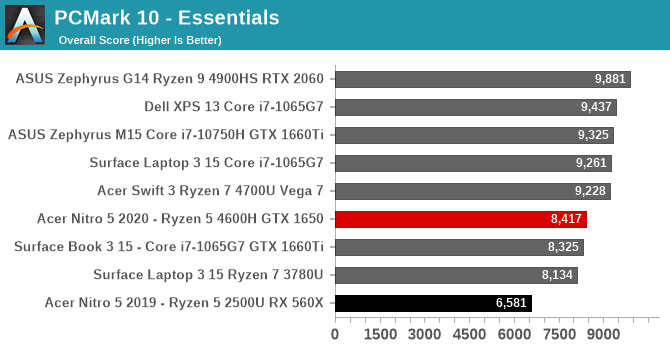
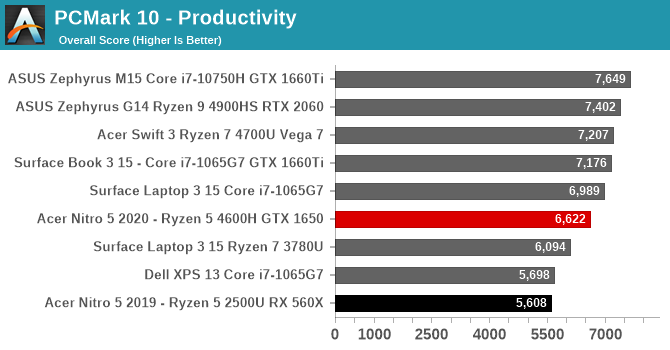
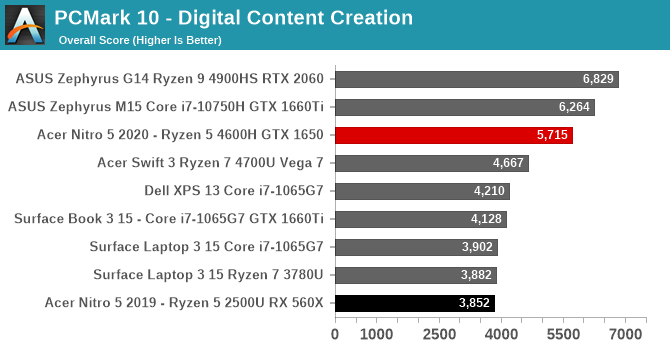
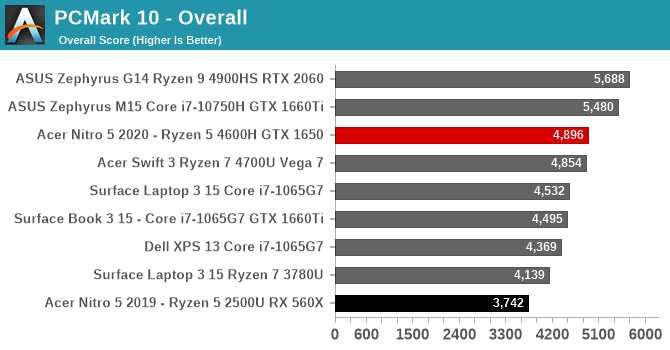
Offering a range of sub-tests, UL’s PCMark 10 simulates real-world tasks for office productivity, digital content creation, and typical tasks a home-user may do such as web and video chats. The Acer Nitro 5 does very well here, although it can not quite match the 8-core Ryzen 7 4700U in many of the tests. The included GTX 1650 does propel it ahead in content creation, however. The ASUS M17, with a 5.0 GHz maximum frequency, does edge the Ryzen 5 4600H, and the large GTX 1660 Ti GPU also helps. However the ASUS Zephyrus G14 with the “35-Watt” Ryzen 9 4900HS and RTX 2060 is able to outshine the rest of the systems.
Cinebench R20
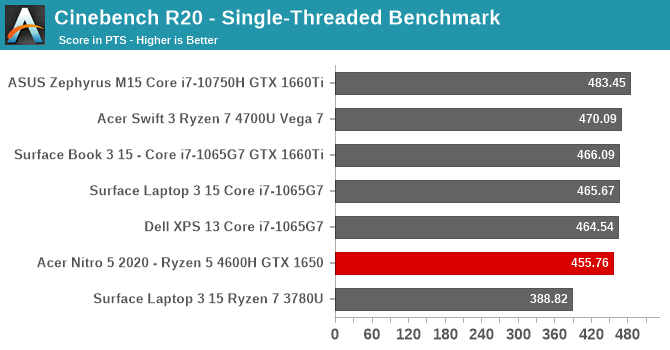
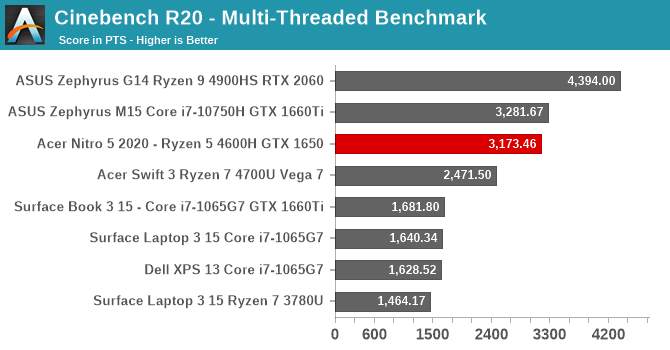
Cinebench is a pure compute workload, testing a CPU’s execution resources without much else getting in the way, like memory. It favors fast frequencies, high IPC, and more cores on the multi-threaded version of the test. The slightly lower boost frequency of the Ryzen 5 4600H, peaking at only 4.0 GHz, holds the system back on the single-threaded results, but with six cores and twelve total threads, the Ryzen 5 competes well with the Core i7-10750H, and stretches its legs on the U-Series processors. The Ryzen 9 4900HS, with 8 cores, 16 threads, and a 4.3 GHz maximum turbo, easily outclasses other processors here.
Handbrake

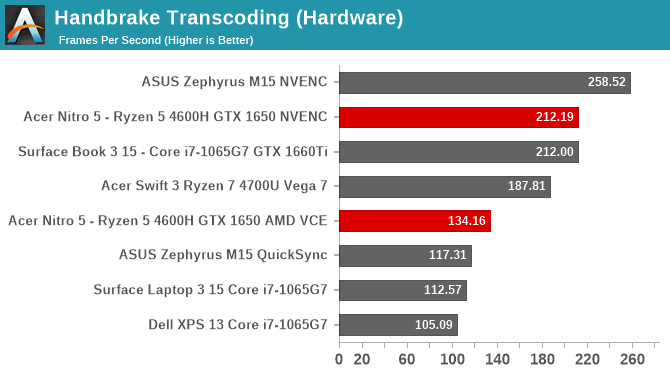
The newly added Handbrake benchmark leverages the CPU, integrated GPU, and discrete GPU if available to transcode video using likely the most popular transcoding tool around. As a much longer test, the TDP plays more of a factor here than on some of the previous results, and the Acer Nitro 5 does very well on this assessment. On pure CPU encoding, the Zen 2 cores can almost keep up with the much higher frequency Core i7-10750H. When using the integrated GPU built into Ryzen, performance is good, although not quite matching the Ryzen 7 4700U we tested in the Acer Swift 3, which despite the smaller TPD, offers a slightly larger iGPU. The GeForce GTX 1650 is faster again, if you need to transcode video in a hurry. Generally, the dedicated media blocks perform the job quicker, but not necessarily with the same quality as the software based encoder, which may factor into your decision on which one to leverage for a transcode job.
7-Zip
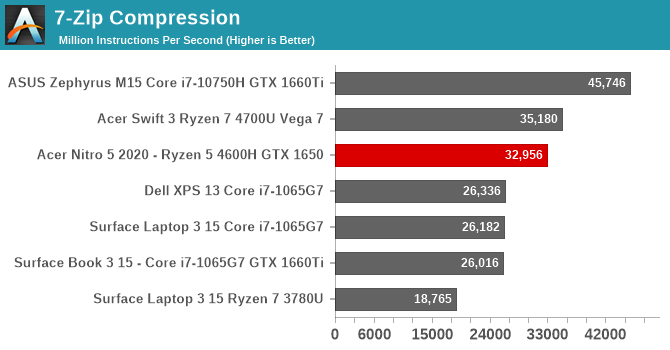
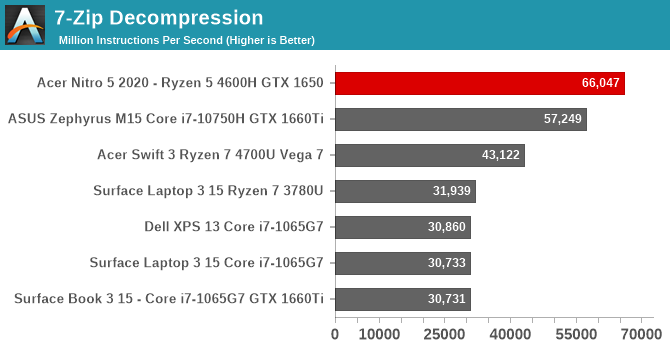
The very popular open-source file compression utility 7-Zip includes a built-in benchmark, showing the compression and decompression rates in MIPS. The Ryzen 5 can’t quite hang with the Ryzen 7 4700U in compression, but the Zen 2 cores do very well in the decompression result.
Web Workloads
Measuring web performance is a factor of both the underlying hardware, as well as the browser, since most web workloads leverage scripting which is compiled just-in-time, so the browser plays a big factor in overall performance. To lock the systems to an even playing field, we have moved to the latest Chromium-based Microsoft Edge browser, and will be utilizing it going forward. We took the opportunity to move away from some of the older, outdated web tests, and are focusing on Speedometer 2.0, which is a DOM performance measurement from the Webkit team, and WebXPRT which is developed by Principled Technologies.
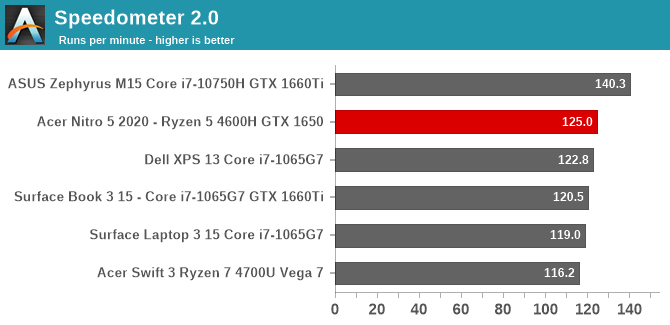
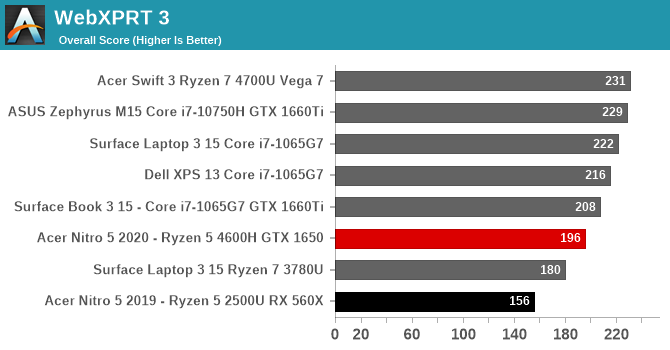
Interestingly, the 6-core, 12-thread Acer Nitro 5 was able to surpass the 8-core, 8-thread Ryzen 4700U in Speedometer, even with a small frequency deficit. WebXPRT, which really favors higher turbos and fast turbo activation, did not do as well on this system.
Storage Performance
The Acer Nitro 5 review unit shipped with a 256 GB Western Digital SN530 drive, which is a PCIe 3.0 x4 NVMe drive. The Acer also offers an additional M.2 port, as well as a 2.5-inch SATA slot for additional expansion. As a low-cost device, the 256 GB drive is small, but adequate when you consider the rest of the internals, and expansion is possible, either via internal drives, or of course USB-based storage to hold a gaming library.
The PCMark 10 storage test uses traces of actual workloads to provide an overall resulting score, and is more useful than a straight up bandwidth test of the drive.
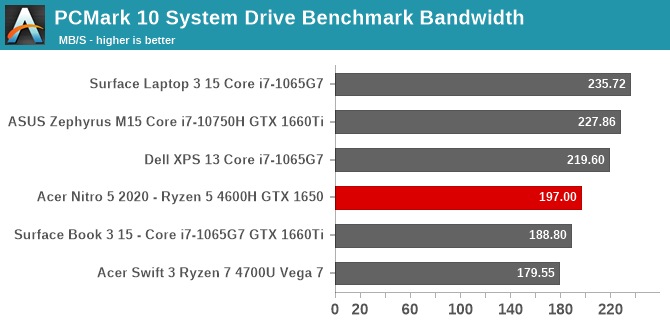
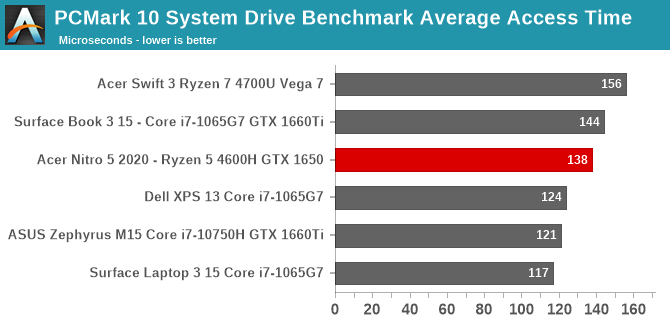

The drive itself, despite being installed in a low-cost device, holds up well against other devices we have tested that cost much more. A larger drive in a gaming system would be nice, due to the massive size of game installs in 2020, but a 256 GB system drive is still welcome since it is pure NVMe SSD.











50 Comments
View All Comments
Brett Howse - Friday, October 9, 2020 - link
Let me re-evaluate when I get something Tiger Lake. Right now I'm still finding that the iGPU solutions are struggling at 1366x768 / 1280x720 in most titles.lakedude - Friday, October 9, 2020 - link
Laptops in this class are right up my alley. You can easily spend $800 on a laptop with zero graphic performance. I've got a Nitro and would buy another, depending on specs/price of course.My taste may not be typical but the monitor does not bother me for 2 reasons.
1) Color gamut is not that noticable to me. Sure I've got OLED screens that look amazing and side by side the Nitro looks washed out by comparison but there are many other worse problems to my eye (like slow switching, limited view angle, low res, etc.).
2) All but a couple times a year I used my laptop "docked" to a keyboard/mouse and monitor so the monitor isn't even in use most of the time. I realize this is a special use case so YMMV.
Other than the screen this thing has specs that would have needed a huge heavy chassis just a few years ago.
Cheap, good specs (cept screen), and fairly light for a 1080p "gaming" system. What is not to like?
lmcd - Friday, October 9, 2020 - link
~4 lb laptops with equal dGPUs are absolutely possible. For example, an upgraded Inspiron 15 would match this in performance in a smaller profile.Linustechtips12#6900xt - Thursday, May 13, 2021 - link
exactly correct if I didn't have to go to college and have something that didn't scream "I'm a fuc*ing gamer B*tch" then I would totally buy thisValantar - Friday, October 9, 2020 - link
It's a shame the Zephyrus M15 is missing from the normalized battery life chart, as that is the most relevant comparison of those in the other charts. For reference if anyone else wonders, with its 76Wh battery it ends up at a normalized battery score of 6.74, noticeably below the Nitro.coolrock2008 - Friday, October 9, 2020 - link
AM i reading this correctly? The difference between the entry level SKU and the the $999 SKU AN515-44-R078 is just the GPU upgrade? $330 to move from 1650 to 1650Ti? Ouch.DanNeely - Friday, October 9, 2020 - link
Also the 144hz display. But since the GPU isn't fast enough to play current games that fast' I'd much rather have seen the 16gb/512gb upgrade instead. Assuming the 144hz panel isn't better quality in ways other than the refresh rate anyway.Brett Howse - Saturday, October 10, 2020 - link
Mid-tier is still the 60 Hz panel so yes only the GPU is different.Galcobar - Sunday, October 11, 2020 - link
Either this (Brett's) comment or the chart on the first page has an error then; the chart shows the middle tier to share the upgraded GPU and screen refresh of the upper tier.Brett Howse - Sunday, October 11, 2020 - link
There was some confusion from Acer on this I think someone edited my chart, but I switched it back now. Only the top-tier model has the 144 Hz display. Acer's marketing materials for the mid-tier said it did, but the spec sheet did not show it, and I clarified with them that the mid tier does in fact not have the 144 Hz.